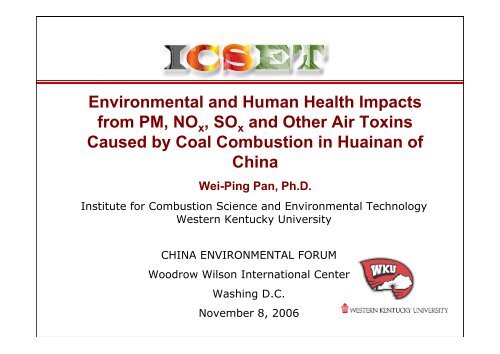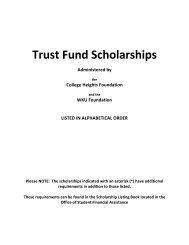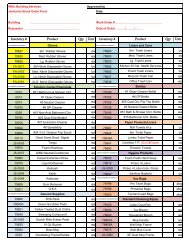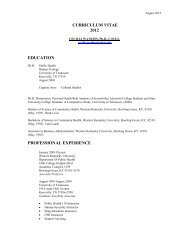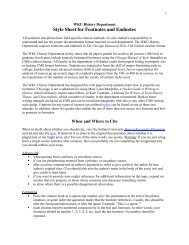Presentation by Wei-Ping Pan, Ph.D. - Western Kentucky University
Presentation by Wei-Ping Pan, Ph.D. - Western Kentucky University
Presentation by Wei-Ping Pan, Ph.D. - Western Kentucky University
Create successful ePaper yourself
Turn your PDF publications into a flip-book with our unique Google optimized e-Paper software.
Environmental and Human Health Impacts<br />
from PM, NO x, SO x and Other Air Toxins<br />
Caused <strong>by</strong> Coal Combustion in Huainan of<br />
China<br />
<strong>Wei</strong>-<strong>Ping</strong> <strong>Pan</strong>, <strong>Ph</strong>.D.<br />
Institute for Combustion Science and Environmental Technology<br />
<strong>Western</strong> <strong>Kentucky</strong> <strong>University</strong><br />
CHINA ENVIRONMENTAL FORUM<br />
Woodrow Wilson International Center<br />
Washing D.C.<br />
November 8, 2006
��China China is the biggest producer and consumer of coal in the<br />
world.<br />
�� 2.11 billion tons of coal in production in 2005;<br />
�� more than 70% to total energy in China from coal combustion.<br />
Coke 7%<br />
Gasoline<br />
and disel<br />
oil 15%<br />
Other 2%<br />
Coal 76%
�� Coal combustion caused<br />
serious air pollution<br />
problems.<br />
SO x<br />
�� SO<br />
NO x<br />
�� NO<br />
�� PM<br />
�� heavy metals
�� Huainan City, Anhui Province<br />
�� Energy base of eastern China<br />
�� so called “Fuel Fuel Power Three<br />
Gorges” Gorges in China (2400 MW, 2400<br />
MW, and 1150 MW)<br />
�� Production of 100 million tons of<br />
coal in 2005<br />
�� One of two sites on Energy Future<br />
and Air Pollution in urban China<br />
and the United Stats Program
�� Ambient air pollution from coal combustion (11 million tons<br />
coal burned in 2004)<br />
�� Fly ash stockpile capacity (6.6 million tons fly ash in 2004)<br />
�� Sinking area due to coal exploration (130 square kilometer<br />
in 2004)
Pollutant Emissions, x10 6 tons<br />
0.2<br />
0.18<br />
0.16<br />
0.14<br />
0.12<br />
0.1<br />
0.08<br />
0.06<br />
0.04<br />
0.02<br />
0<br />
SO 2<br />
Smoke-Dust<br />
1995 1998 2000 2003 2007 2010 2020<br />
Year<br />
Total Coal<br />
Consumption<br />
80<br />
70<br />
60<br />
50<br />
40<br />
30<br />
20<br />
10<br />
0<br />
Total Coal Consumption, x10 6 tons
��In In Huainan<br />
– allergic asthma: up to 2% of the total population;<br />
– chronic bronchitis: 2% of the total population;<br />
– conjunctivitis: 20% of eye illness;<br />
– coryza: 2% of the total population;<br />
– large amounts of people with occupational disease.
Coal Quality Data<br />
Base Construction<br />
AUST<br />
Huainan Environmental Automatic<br />
Monitoring Center<br />
WKU Hoffman Institute<br />
China Environmental Health Project<br />
WKU ICSET<br />
Monitoring for pollutants from three power<br />
plants; sampling air quality of Huainan<br />
mining area; investigating PM distribution<br />
Air Quality and Health<br />
Huainan Environmental Automatic<br />
Monitoring Center<br />
School of Medicine<br />
Modeling<br />
Investigating how coal-smoke-induced<br />
particles affect on human health
��Improve Improve Huainan’s Huainan s monitoring system for SO x, , NO x, ,<br />
PM 10 and other air toxins resulting from coal-fired coal fired<br />
power and chemical plants<br />
�� Train and educate Chinese scholars in the latest<br />
environmental technologies;<br />
��Reduce Reduce the coal-burning coal burning related health problems<br />
��Ensure Ensure quality of life and residence through<br />
cooperation between WKU and Chinese partners
��Institute Institute for Combustion Science and Environmental<br />
Technology (ICSET): extensive experience in the study of<br />
coal combustion, combustion,<br />
waster material incineration and pollutant<br />
emissions; emissions<br />
– funding from government agencies: DOE, USDA, NASA,<br />
DOD, EPA and NSF<br />
– funding from organizations: EPRI, ICCI<br />
– funding from industrial: power industries and others
��Provide Provide state-of state of-the the-art art technologies to train Chinese scholars and<br />
students about sampling and analysis of various pollutants;<br />
��Ensure Ensure all measurement results and data quality.<br />
��Hold Hold a related workshop for Chinese scholars.<br />
��Co Co-sponsor sponsor short course on the health impacts of coal in China.
��Anhui Anhui <strong>University</strong> of Science and Technology (AUST):<br />
located in Huainai, accomplished significant achievements in<br />
cleaner coal technology and protection from occupational<br />
disease: disease<br />
– Huainan Environmental Protection Agency will cooperate<br />
with Research Center of Environmental Science and<br />
Engineering of AUST, School of Medicine of AUST;<br />
– Huainan Environmental Automatic Monitoring Center<br />
(HEAM) will provide database and partial equipment for<br />
AUST research.
��Obtain Obtain accurate data on the coal-burn coal burn caused pollutant in<br />
Huainan;<br />
��Provide Provide fundamental understanding and important information of<br />
ground-level ground level air pollution for local policy makers;<br />
��Share Share with Chinese partners US regulatory environmental and<br />
compliance policies, such as self-reporting, self reporting, emissions trading and<br />
tax-related tax related incentives, coupled with tough enforcement.<br />
�� Allow public aware of public health problems, further improve<br />
public health problems caused <strong>by</strong> coal consumption.<br />
��Adopt Adopt the new type of monitoring in Huainan in the near future.


